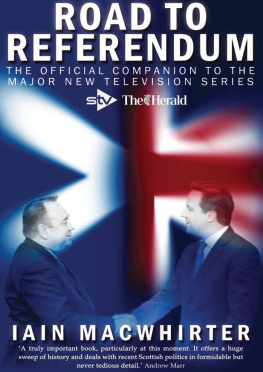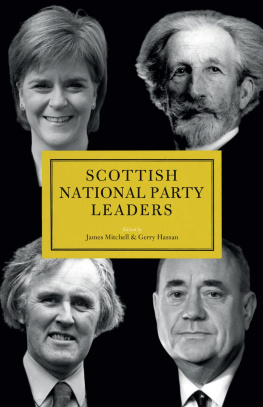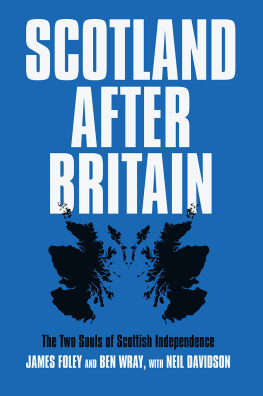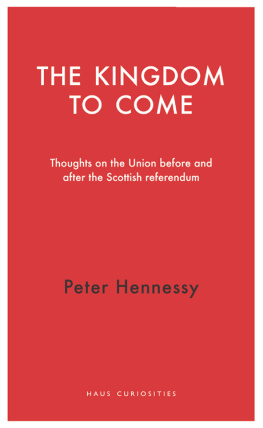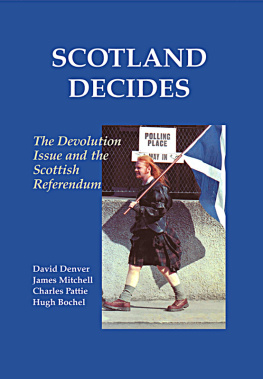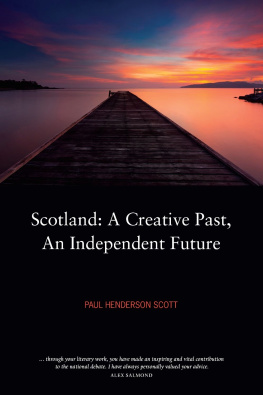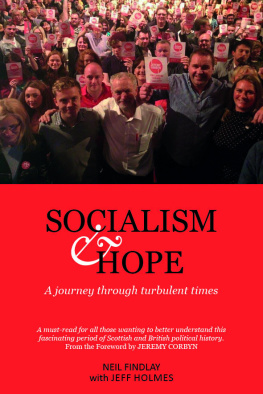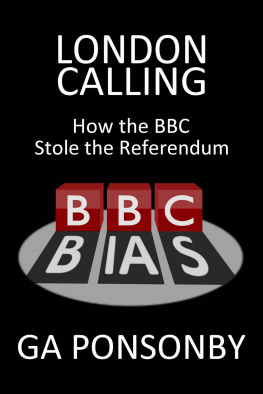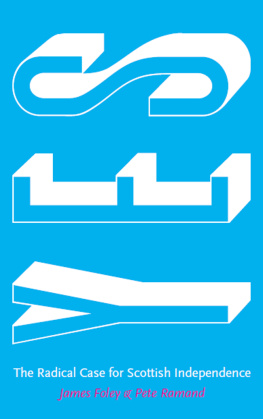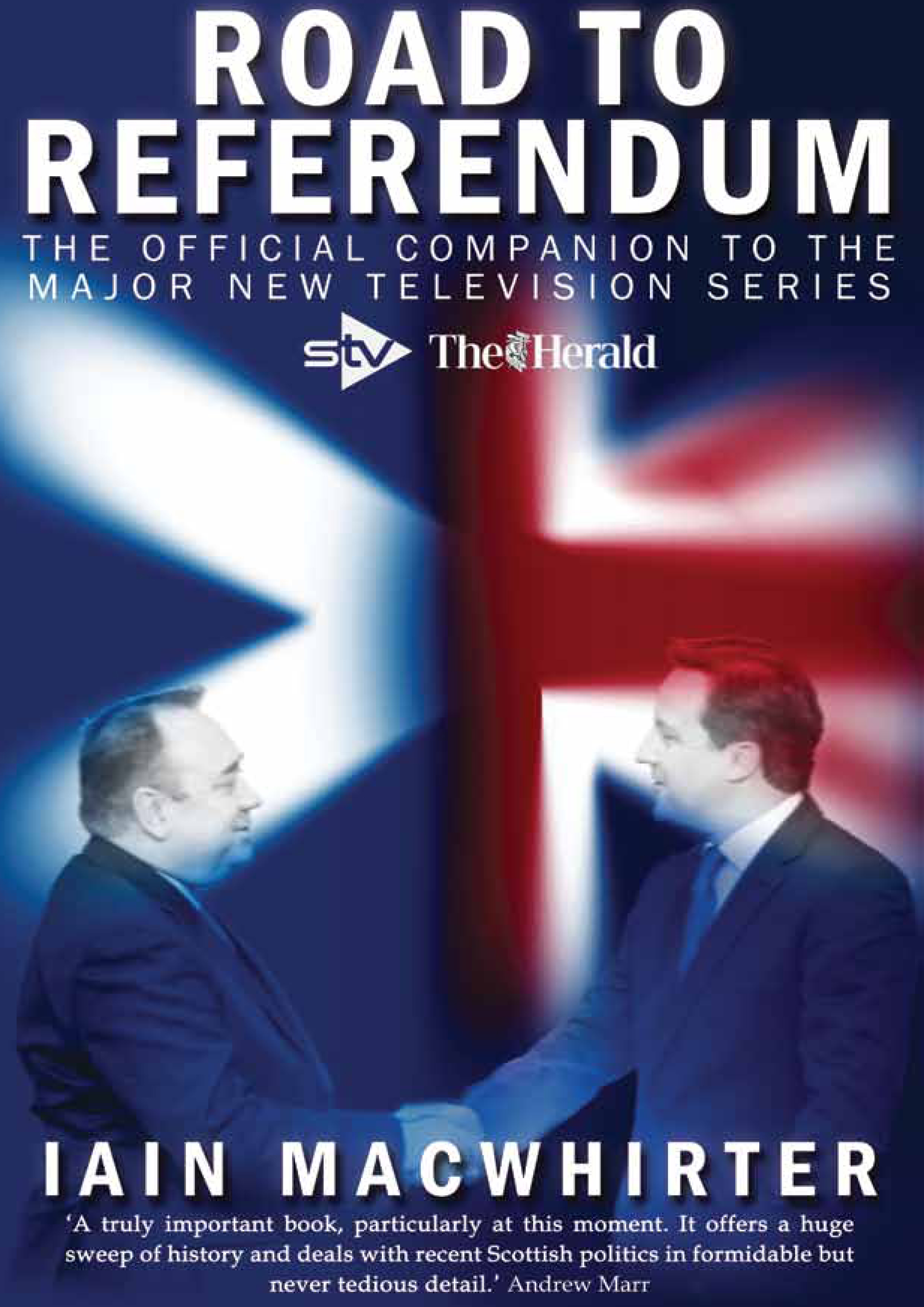ROAD TO REFERENDUM
THE OFFICIAL COMPANION TO THE
MAJOR NEW TELEVISION SERIES

IAIN MACWHIRTER

Verso
Road To Referendum
Iain Macwhirter
First Published 2013
Published by Cargo Publishing
SC376700
Iain Macwhirter 2013
This book is sold subject to the condition that it shall not, by way of trade or otherwise, be lent, resold, hired out or otherwise circulated without the publishers prior consent in any form or binding other than in which it is published.
The moral right of the author has been asserted.
The opinions contained herewithin this book are those of the author and do not reflect the views of the publisher, Herald Times Group or STV or any of their subsidary companies or successors.
Printed & Bound in Scotland by Bell & Bain
Cover design and typeset by Craig Lamont
www.cargopublishing.com
To Chrissie - if she d only known
P R E F A C E
T h i s b o o k began life as an accompaniment to a television series, Road to Referendum , which traces the extraordinary changes in Scottish politics in the past fifty years as we have gone from being at the very heart of the Union to facing a referendum on independence. However, the road is rather longer travelled than that. The wars of independence in the Middle Ages, when Scotland first asserted its independence and defined itself as a nation, are clearly where the story of Scottish Nationalism really begins.
But this isnt intended to be a history book and I have only included sketches of key periods in Scottish history to the extent that they make sense of what is happening in the present. For example, the current arguments about whether Scotland was extinguished by the Treaty of Union clearly require some understanding of how and why Scotland relinquished its political autonomy in 1707. Similarly, the Darien colonial adventure in 1699 is important mainly because of the way it is used to this day as shorthand for either English perfidy or Scotlands economic inadequacy.
As a journalist, I venture onto the minefield of Scottish history with trepidation and my accounts will no doubt be contested by scholars. But I have tried to write this for a wider audience than just Scots and I have tried to provide an introduction for people not acquainted with Scottish politics and who have only a vague notion of what has been happening here and cannot be expected to know or care much about the Caledonian Antisyzygy or the 57 varieties of Devolution Max.
Chapters 7 to 12 cover broadly the territory of the TV documentaries, and I am indebted to STV, not just for the opportunity to present a three-part series which was long overdue, but also for being able to draw directly on many of the interviews in the programmes and to the Herald & Times Group for making the project happen. This is not a recapitulation of a television script and these chapters cover very much more ground than a television programme ever could. All opinions expressed in this book are mine alone and should not be taken as in any way reflecting the views of STV or the Herald & Times Group.
This book in part represents my own attempts to come to terms with the astonishing growth in Scottish national identity during my lifetime. I was born in Margaret Thatchers constituency in London and brought up in Edinburgh, where I was completely deaf to the appeal of Scottish Nationalism, even though my mother became a prominent member of the SNP. I spent half of my professional life as a journalist in London, mainly in Westminster, and the rest in Scotland, latterly at Holyrood, where I have been continually surprised by the rapidity of political change in Scotland. I have a great affection for Scotland; I feel I understand its confusion over its identity, and its uncertainty over what, if anything, it still means to be a part of Great Britain.
I am not a member of the Scottish National Party and many Nationalists will find my portrayal of the movement at times unsympathetic. Labour politicians will assume, as they generally do, that Im a closet Nat. Both sides now accept that Scotland could become a viably independent country. At time of writing, there is no firm evidence yet that the Scottish people want to go to the trouble of detaching themselves from the United Kingdom, a country in which they feel at home, even as they depart from it politically. Geography is destiny and Scotland and England are condemned to coexist on this small island off the coast of Europe and live in each others worlds. But it would be a great mistake to assume that Scots will remain within the UK come what may it will have to change to survive.
Like Robert the Bruce, the excommunicated Scottish king who defeated the English at Bannockburn in 1314 despite having spent most of his life fighting for England, the Scots will only sue for independence once they have explored every other conceivable option, and when they have established beyond doubt that it is in their material interest so to do. That moment may never come. But in the meantime, the constitutional relationships between the constituent parts of this extraordinary island will undergo a process of permanent renegotiation. If you halve the distance between two points, and then keep on halving it, you go forward but you never arrive.
I N T R O D U C T I O N
I v e n e v e r been much interested in the Edinburgh Military Tattoo. Sitting in the rain watching pipe bands marching up and down is not my idea of an enjoyable evening, though more than 200,000 people pay to see it every year during the Edinburgh Festival. So, it was with some surprise that I received an invitation to accompany the First Minister of Scotland to the Royal Box for the 2007 Military Tattoo. How could I refuse?
Alex Salmond had only just been installed as First Minister of Scotland after the first election victory by the Scottish National Party in its 80-year history. I dont know what the Brigadiers and Lieutenant Colonels made of him, but Salmond certainly seemed to find it all hilarious, sitting in for the Queen on her own portable throne playing with the light that flashed every time he had to rise to take the salute from some regiment of foot. I wasnt quite so comfortable, sitting next to Michael Martin, the Speaker of the House of Commons, who a few years previously had reported me to the Sergeant at Arms in Westminster for an article I had written on MPs expenses.
As a journalist who has witnessed the career of Alex Salmond for a quarter of a century, Ive been used to surprises but this was positively surreal. Here was the former leftist who had once been expelled from the SNP for being a republican socialist, now sitting at the heart of the Scottish establishment assuming such a thing exists. The leader of the Scottish National Party leading the 10,000-strong Tattoo audience in a rendition of God Save the Queen . Hugh MacDiarmid, the Marxist poet who co-founded the National Party of Scotland, would be turning in his grave, along with Queen Victoria and James Keir Hardie.
After the salutes, the flutes of champagne arrived and Salmond staked his ground wherever there is attention, the First Minister will always be at the centre of it. I can see youre getting to like this, I remarked. Youll be wanting to start a war next.

